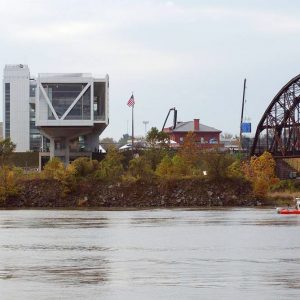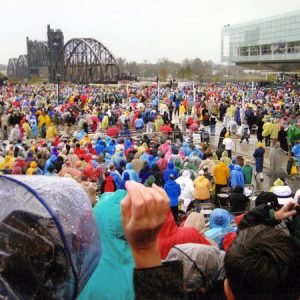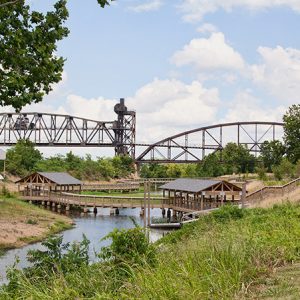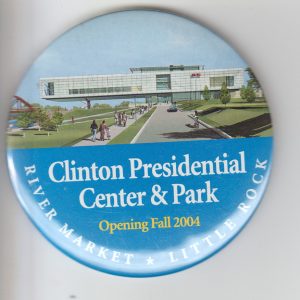calsfoundation@cals.org
William J. Clinton Presidential Center and Park
aka: Clinton Library
The William J. Clinton Presidential Center and Park is located on a thirty-acre city park in downtown Little Rock (Pulaski County). The center comprises the William J. Clinton Presidential Library and Museum, the William J. Clinton Presidential Foundation, the University of Arkansas Clinton School of Public Service, 42 bar and table (an on-site restaurant), and the Rock Island Railroad Bridge. The Clinton Museum Store, also part of the center and managed by the Clinton Foundation, is in the lobby of the Clinton Library.
The William J. Clinton Presidential Library and Museum is maintained, managed, and staffed by the National Archives and Records Administration (NARA). The Presidential Libraries Act of 1955 provided that presidents may raise funds for building their libraries with no cost to the government. After they are built, presidential libraries become federal government buildings under the management of NARA. Before President Jimmy Carter signed the Presidential Records Act (PRA) in 1978, former presidents had previously donated their presidential papers to their libraries. The PRA, passed by Congress in the wake of the Watergate scandal, mandated that presidential records become the property of the government at the end of a president’s administration. The PRA instructs the National Archives to process presidential records to make them available to the public. NARA archivists on staff at presidential libraries carry out those duties.
The William J. Clinton Presidential Library and Museum was formally dedicated on November 18, 2004. At that time, the William J. Clinton Presidential Foundation, represented by Chelsea Clinton, handed over the keys to the building to the archivist of the United States. The Clinton Library became the eleventh presidential library in the Presidential Library System managed by NARA.
The William J. Clinton Presidential Library and Museum is a modern building designed by Polshek Partnership of New York. Led by James Polshek, the architects drew upon President Bill Clinton’s metaphorical idea of building a “bridge to the twenty-first century” in their design. The building is a rectangular glass and steel structure jutting out toward the Arkansas River and the Rock Island Railroad Bridge. The interior museum space was designed by Ralph Applebaum Associates of New York and London. The organizational core of the museum is a timeline of Clinton’s presidential terms that runs through the middle of the first floor, with alcoves of various domestic and foreign policy subjects along both sides. The museum also has full-scale replicas of the Cabinet Room and the Oval Office, a Great Hall for special events, and classrooms for educational programs. Along with the permanent exhibit, there is a room for varying exhibits on the second floor of the museum. In this space, the museum staff has the opportunity to draw from the collection of approximately 84,600 artifacts to showcase to the public. Most of the artifacts are gifts given to President Bill Clinton during his administration.
The “library,” or archival wing of the building, houses the records and artifacts of the administration. The archival holdings of the Clinton Presidential Library include almost 80 million pages of paper documents, 1.85 million photographs, 12,500 video tapes, and over 6,000 audio tapes. There are research rooms for both textual and audio/visual researchers. The textual research room has a collection of books relating to President Clinton and his administration. A small percentage of Clinton’s presidential records are now open for research. Archivists are presently processing records on various topics in response to Freedom of Information Act (FOIA) requests. As records are opened, the finding aids are listed on the Clinton Library website.
The William J. Clinton Presidential Foundation is housed in the renovated Choctaw Railway Station on the park grounds. The building was dedicated in the fall of 2004 as Sturgis Hall, named for Roy and Christine Sturgis, benefactors of the renovation. The building is also home to the University of Arkansas Clinton School of Public Service. The Clinton Foundation supports the work of the former president in his global efforts to fight HIV/AIDS, facilitate economic empowerment and leadership development, and bring about racial, ethnic, and religious reconciliation. The foundation continues to raise funds for these efforts, while also providing various programs for the public at the Clinton Presidential Center.
The Clinton School of Public Service opened its doors to its first class in the fall of 2005. It is the first school in the country to offer a Master of Public Service (MPS) degree. The school also offers a Certificate in Public Service (CPS). The Clinton School routinely sponsors symposia and conferences for the public, and guest lecturers come from around the world.
The Clinton Museum Store, located in the lobby of the Clinton Library, carries a wide variety of items such as clothing, dishes, toys, books, and trinkets featuring the logo of the William J. Clinton Presidential Center. Proceeds from the Clinton Museum Store support the Clinton Foundation.
The project to revamp the Rock Island Railroad Bridge for pedestrian use across the Arkansas River from Little Rock to North Little Rock (Pulaski County) cost $10.5 million in federal and local funds, augmented by donations. Former president Bill Clinton dedicated the revamped bridge and adjoining William E. Clark Wetlands on September 30, 2011, before a crowd of 1,750. The bridge serves as the eastern terminus of the Arkansas River Trail, a recreational path for walking and cycling that is shared by Little Rock and North Little Rock.
In August 2023, the center announced expansion plans that would include housing the archives and papers of Hillary Rodham Clinton.
For additional information:
Clinton Museum Store. http://www.clintonmuseumstore.com (accessed February 9, 2023).
Dickens, Melanie. “A Legacy for the 21st Century.” At Home in Arkansas, November 2005, pp. 46–50.
Dillon, David. “William J. Clinton Presidential Center Making a Statement.” The Dallas Morning News. November 18, 2004, p. 28A–29A.
Holt, Tony. “Clinton Center Foresees Growth.” Arkansas Democrat-Gazette, August 9, 2023, pp. 1A, 4A. Online at https://www.arkansasonline.com/news/2023/aug/09/clinton-center-foresees-growth/ (accessed August 9, 2023).
Koch, Christina. “An Environmental Legacy: Former President Clinton’s Center Is a Symbol of His Presidency and Allegiance to the Environment.” Eco-structure (January/February 2006): 17–24.
Lancaster, Grant. “Clinton Center’s 20th Year Prompts Look Back.” Arkansas Democrat-Gazette, January 26, 2024, pp. 1B, 3B. Online at https://www.arkansasonline.com/news/2024/jan/25/panelists-reflect-on-history-impact-of-clinton/ (accessed January 26, 2024).
University of Arkansas Clinton School of Public Service. http://www.clintonschool.uasys.edu (accessed February 9, 2023).
William J. Clinton Presidential Foundation. http://www.clintonfoundation.org (accessed February 9, 2023).
William J. Clinton Presidential Library and Museum. http://www.clintonlibrary.gov (accessed February 9, 2023).
Rhonda Young
William J. Clinton Presidential Library and Museum
 Architectural Styles
Architectural Styles Clinton Library
Clinton Library  William J. Clinton Presidential Center and Park Dedication
William J. Clinton Presidential Center and Park Dedication  Clinton Presidential Library and Museum
Clinton Presidential Library and Museum  Clinton Presidential Library and Museum
Clinton Presidential Library and Museum  Presidential Park Wetlands
Presidential Park Wetlands  William J. Clinton Presidential Center and Park Dedication Ticket
William J. Clinton Presidential Center and Park Dedication Ticket  William J. Clinton Presidential Center Construction
William J. Clinton Presidential Center Construction  Clinton Center and Park Button
Clinton Center and Park Button 



Comments
No comments on this entry yet.